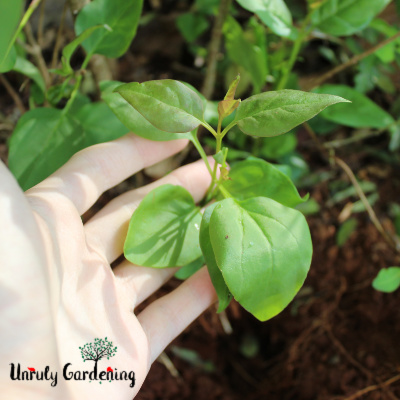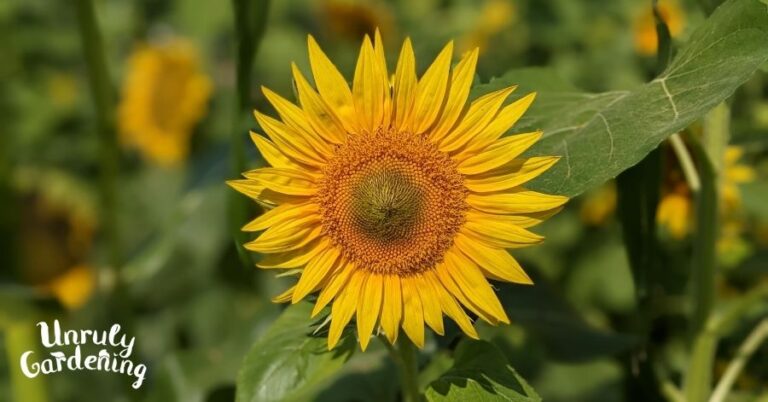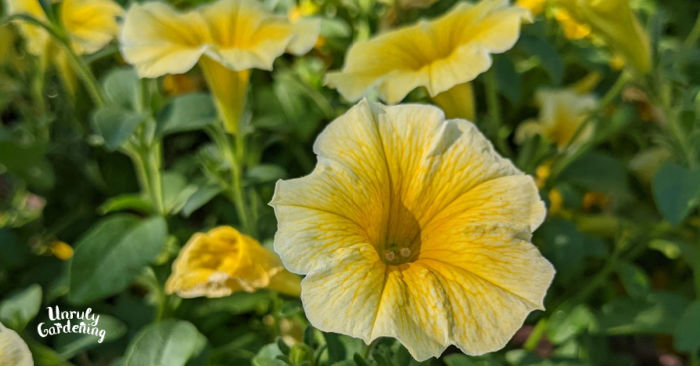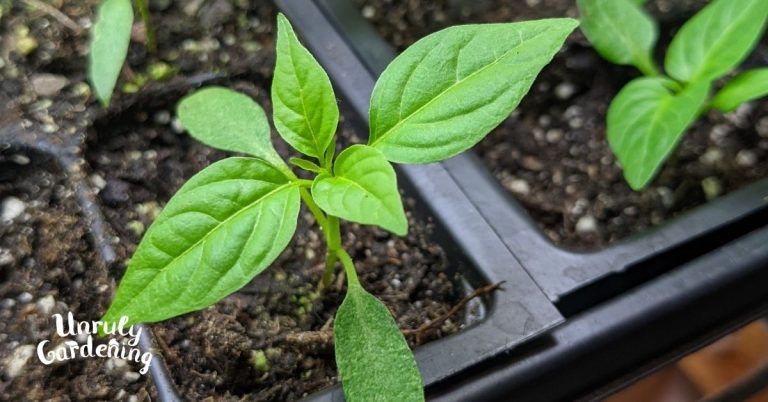How to Plant & Grow Boysenberries
Delicate, full of flavor, and packed with brilliant sweet juice, boysenberries were created by bringing together blackberries, raspberries, loganberries, and dewberries, resulting in a bramble that produces large, dark purple fruits.

Delicious in cobblers, pies, preserves, and sauces, as well as an absolute treat to eat fresh, this uncommon berry is often overlooked due to its thorns and the fragility of its fruits.

Boysenberries: At a Glance
- Growing Zones – USDA Zones 5-9
- Soil requirements – pH 6-7, rich, well-draining
- Sun requirements – Full sun
- When to plant outside – 2-4 weeks before your estimated final frost date, or all through spring.
- Spacing – Space plants 5-6 feet apart from one another.
- Drought-tolerant? – No
- Needs support? – Yes
- Thorns – Yes
- Fruits – Big, plump, juicy, dark purple berries produced on second-year canes.

About
Boysenberries aren’t as common a sight in the home garden as their more well-known relatives, blackberries and raspberries. Long, thorn-covered canes produce bright green leaves and white flowers in spring, and big, dark-purple berries in summer.
The berries are only produced on second-year canes, known as floricanes. The canes are biennial, living two years in total – one as a new cane (also known as a primocane), and then one as a fruit-bearing floricane- dying after the fruiting season is finished.
The roots are perennial, however, and gives this plant its 15-20 year lifespan. The plant will put out new primocanes from the roots every year, giving you a constant supply of first and second year canes.
The canes put off suckers from the roots, and will root and create new plants where the canes come in contact with the ground. This is known as ‘tip-rooting’, and can be done intentionally to create new plants.
As for the fruit itself, compared to a blackberry, boysenberries on average are larger, heavier, and tend to be sweeter in taste. Thin-skinned and packed full of vibrant, flavorful juice, the berries are fragile and don’t ship well, which is why you don’t usually see them fresh in grocery stores.
Much like alpine strawberries, this really is a treat you have to grow yourself if you want to experience them fresh!

Planting
Advice, Location, pH
Use thick gloves when handling the young plants. Even the smallest ones are covered in sharp, fine, almost hair-like thorns, and they can hurt!
Select a planting area that gets full sun, meaning 6-8 hours of direct sunlight. You want a location with good drainage, and an ideal soil pH of around 6-7. Space your plants 5-6 feet apart, and make sure you have enough room to set up a trellis!
The general advice given is to plant your boysenberries outside 2-4 weeks before your estimated final frost date. You can plant them later in the year as well, however. It won’t hurt them to be planted later in the spring, so don’t worry too much about timing. Ensure your plants have already been exposed to outside weather in a hardening-off process before planting for best results.

How to Plant Boysenberries
To plant, dig a hole, and mix soil from the hole with a generous amount of added compost. You can also add a granular fertilizer (20-20-20 is the most commonly recommended mix) if desired, but it’s not always necessary – we just use compost for ours.
Spread out the roots before covering them with soil, tamping down firmly with your hands. Water well – at least a gallon per plant- and mulch thickly. Aim for 1-2 inches of mulch. Wood chips are what we use. Boysenberries are not very drought-tolerant, so mulching is important!
Continue to regularly provide 1-2 inches of water a week as plants become established.

Trellising
Boysenberries require support. They sprawl all over the ground if you don’t, making them more prone to soil-borne diseases, tip-rooting everywhere, rapidly becoming an impassible thicket. Trellising keeps them from becoming a mess!
To manage our boysenberries, we trellis them like we do our blackberries, by training them along lines of wire strung between fence posts. Some people use a cattle panel, bent into an arch.
The goal is to get the canes off the ground, and to allow more ease of access to the vines for picking. Feel free to try and get creative with it!

Care
Boysenberries, as a bramble, are rather hands-off plants once they’re established, at least until the summer pruning. They are capable of running into a number of diseases and pests, which you should watch for, but otherwise, much of their care is simply waiting for them to fruit, or else removing old canes.
It is also recommended to top-dress your boysenberries every year with a thin layer of compost. Work it into the soil, and make sure to maintain your mulch. In times of drought, make sure to water them well.
Pruning boysenberries to remove old wood and keep them healthy and producing is a hefty topic in its own right. We’re still working on a post all about boysenberry pruning, so keep an eye out for that this year!

Pests and Diseases
If it preys on a blackberry or a raspberry plant, it may come for your boysenberries. Inspect regularly for aphids, spider mites, cane borers, raspberry bud moths, leafrollers, and Japanese beetles, among others.
Squirrels and birds also love boysenberries, and you’ll have to beat them to the harvest if you want them to leave any for you. This is not an easy feat! The wildlife gets about 75% of our boysenberry harvest each year! We’re actively propagating and planting more boysenberries each year, so hopefully one day there will be enough boysenberries for us all to enjoy.
Deer will also eat the leaves and canes, so make sure to protect your plants – especially the young ones – with tall fences or wire cages, if you live somewhere they’re a problem.
There are a number of rusts and blights that your boysenberry can catch. In the case of both rusts and blights, pruning out the canes and promptly burning them may help remove the disease. Always make sure to disinfect your pruning shears after pruning diseased plants.
You can avoid many of these problems by making sure your tools are clean, that you plant disease-free plants, and that your soil is well-draining. Mulching the bases of the plants helps prevent soil-borne disease, while good air circulation between the plants can help prevent other diseases.
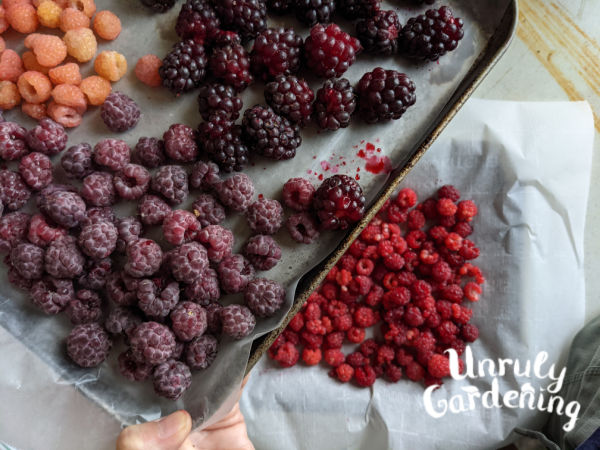
Harvesting & Storing
Ripe boysenberries are plump and fully colored a dark purple. The berries will be soft, not firm, to the touch. Picking them should feel much like picking a slightly softer, fully ripened blackberry.
The berries are very delicate, tender, and heavy for their size. They’re easily crushed once the bucket starts filling up. Fill containers shallowly when picking to prevent this.
Not all of the boysenberries on the plants will be ripe all at once. Check the plants daily once the berries start changing color. Pick berries as they ripen. And keep an eye out – the squirrels and birds will be drawn to the ripe berries, and they can steal more of your boysenberries than you’d think possible in a surprisingly short amount of time!
Boysenberries can spoil swiftly once picked. If possible, it’s best to freeze, eat, preserve, or cook your boysenberries as soon as possible after picking.

Fresh Boysenberries
Boysenberries are, of course, delicious eaten fresh. Straight from the garden into your mouth is a classic berry-eating method for a reason!
You can keep whole, undamaged berries in the refrigerator for a day or so, but don’t leave them out on the counter! They don’t hold up well to being kept at room temperature for extended amounts of time, we’ve found.
In most home garden situations, it is unlikely you’ll pick enough off your plants at once to make a proper batch of jam, jelly, or syrup with only the fresh berries. In this case, you’ll need to collect and freeze your boysenberries as you pick them until you have enough.
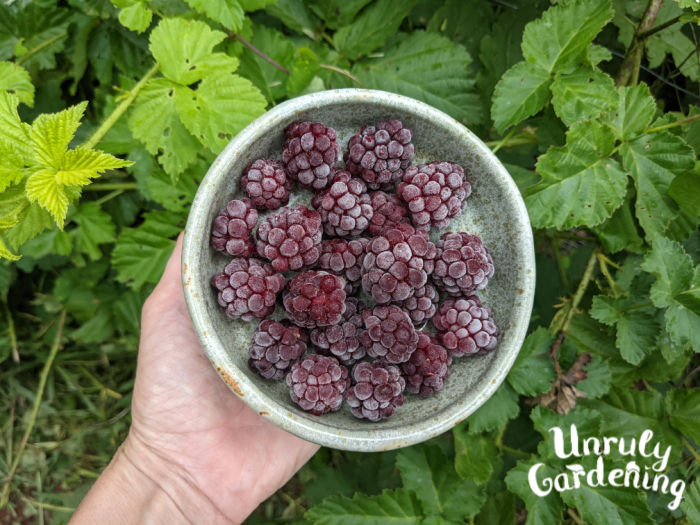
Frozen Boysenberries
Frozen boysenberries are used pretty much like fresh berries. It’s best to freeze the berries as soon as possible after picking.
All you have to do is cover a flat baking pan or cookie sheet with parchment or wax paper. Spread out your boysenberries in a single layer on top of this. Pick through the berries carefully. Remove any berries that are spoiled, rotting, or bug-eaten.
Place pan in the freezer, and leave until berries are fully frozen. Remove frozen boysenberries from the freezer. Portion out and freeze berries in freezer-safe bags. Make sure to squeeze out as much air as possible from the bags. You could alternatively use a vacuum-sealer, like seal-a-meal, for even better results.
Return boysenberries to freezer. Keep fully frozen at all times. Do not allow to thaw and then re-freeze.
Frozen boysenberries are good for at least 1 year, as long as they’re properly sealed. They can potentially last longer. Improper storage can shorten their shelf life. Taste them, and if they taste like freezer, they’re no good. Toss ’em in the compost heap!

Using
Both fresh and frozen boysenberries can be made into jam, jelly, and syrup, just to start with. Canning these sweet berries means you can have access to a taste of summer all year around! Canned boysenberry goods have a shelf life of 1 year.
As for on the cooking side, try making a sauce, or perhaps a cobblers, or a pie. Or put them in ice cream! If none of that sounds interesting, then how about boysenberry lemonade, or maybe boysenberry muffins. Still just not tickling your fancy? What about a boysenberry cheesecake?
Alternatively, you can simply find recipes that call for blackberries, and try using boysenberries in them instead. Experiment, and see what you can come up with!

